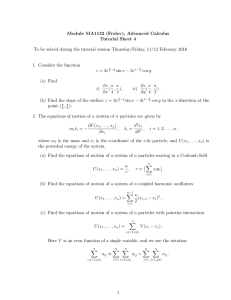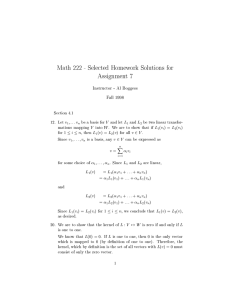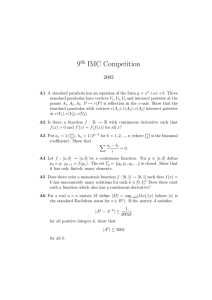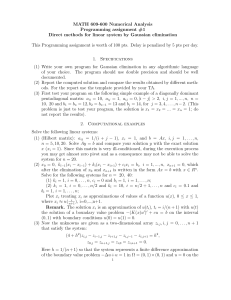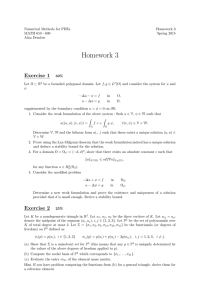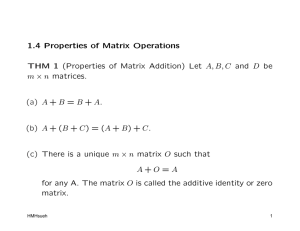Document 10841110
advertisement
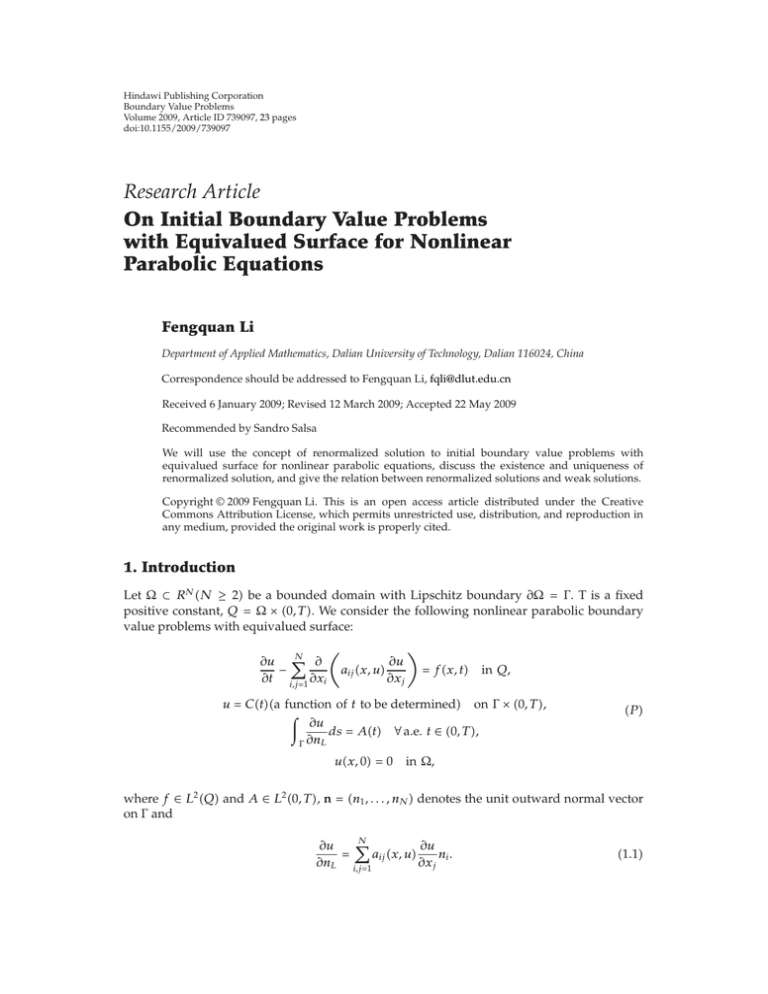
Hindawi Publishing Corporation
Boundary Value Problems
Volume 2009, Article ID 739097, 23 pages
doi:10.1155/2009/739097
Research Article
On Initial Boundary Value Problems
with Equivalued Surface for Nonlinear
Parabolic Equations
Fengquan Li
Department of Applied Mathematics, Dalian University of Technology, Dalian 116024, China
Correspondence should be addressed to Fengquan Li, fqli@dlut.edu.cn
Received 6 January 2009; Revised 12 March 2009; Accepted 22 May 2009
Recommended by Sandro Salsa
We will use the concept of renormalized solution to initial boundary value problems with
equivalued surface for nonlinear parabolic equations, discuss the existence and uniqueness of
renormalized solution, and give the relation between renormalized solutions and weak solutions.
Copyright q 2009 Fengquan Li. This is an open access article distributed under the Creative
Commons Attribution License, which permits unrestricted use, distribution, and reproduction in
any medium, provided the original work is properly cited.
1. Introduction
Let Ω ⊂ RN N ≥ 2 be a bounded domain with Lipschitz boundary ∂Ω Γ. T is a fixed
positive constant, Q Ω × 0, T . We consider the following nonlinear parabolic boundary
value problems with equivalued surface:
N
∂
∂u −
∂t i,j1 ∂xi
∂u
aij x, u
∂xj
fx, t
in Q,
u Cta function of t to be determined on Γ × 0, T ,
∂u
ds At ∀ a.e. t ∈ 0, T ,
Γ ∂nL
ux, 0 0
P in Ω,
where f ∈ L2 Q and A ∈ L2 0, T , n n1 , . . . , nN denotes the unit outward normal vector
on Γ and
N
∂u
∂u
aij x, u
ni .
∂nL i,j1
∂xj
1.1
2
Boundary Value Problems
There are many concrete physical sources for problem P , for example, in the
petroleum exploitation, u denotes the oil pressure, and At is the rate of total oil flux per
unit length of the well at the time t; in the combustion theory, u denotes the temperature, for
any fixed time t, the temperature distribution on the boundary is a constant to be determined,
while, the total heat At through the boundary is given cf. 1–7. For linear equations, the
existence, uniqueness of solution to the corresponding problem are well understood cf. 1–
3, for the purpose, the Galerkin method was used. For semilinear equations, the existence of
global smooth solution was obtained in 7 in which a comparison principle was established.
If aij x, u is locally Lipschitz continuous with respect to the second variable, the existence
and uniqueness of bounded weak solution to problem P have been discussed in 8 under
the hypotheses of f ∈ Lq Q and A ∈ Lr 0, T with q > N/2 1, r > N 2. However, if
f ∈ L2 Q and A ∈ L2 0, T , we cannot get a bounded weak solution. In order to deal with
this situation, we will introduce the concept of renormalized solution to problem P and
discuss the existence and uniqueness of renormalized solution.
The paper is organized as follows. In Section 2, we introduce the concept of
renormalized solution and prove the existence of renormalized solution to problem P . In
Section 3, uniqueness and a comparison principle of renormalized solution to problem P are
established. In Section 4, we discuss the relation between renormalized solutions and weak
solutions for problem P .
2. Existence of Renormalized Solution to Problem P In order to prove the existence of renormalized solution to problem P , we make the
following assumptions.
Let aij : Ω × R → R be Carathéodory functions with 1 ≤ i, j ≤ N. We assume that
aij ·, 0 ∈ L∞ Ω and for any given M > 0 there exist dM ∈ L∞ Ω and a positive constant λ0
such that for every s, s1 , s2 ∈ R, ξ ξ1 , . . . , ξN ∈ RN , and a.e. x ∈ Ω,
aij x, s1 − aij x, s2 ≤ dM x|s1 − s2 |,
N
|sk | ≤ M, k 1, 2,
aij x, sξi ξj ≥ λ0 |ξ|2 .
2.1
2.2
i,j1
Set
V v ∈ H 1 Ω|v|Γ constant .
2.3
Under hypotheses 2.1-2.2 and f ∈ L2 Q, A ∈ L2 0, T , we cannot obtain an L∞
estimate on the determined function Ct; thus, we cannot prove the existence of bounded
weak solutions to problem P , hence aij ·, uDj u may not belong to L2 Q. In order to
overcome this difficulty, we will use the concept of renormalized solution introduced by
DiPerna and Lions in 9 for Boltzmann equations see also 10–12.
Boundary Value Problems
3
As usual, for k > 0, Tk denotes the truncation function defined by
⎧
⎪
k,
⎪
⎪
⎨
Tk v v,
⎪
⎪
⎪
⎩
−k,
if v > k,
if |v| ≤ k,
2.4
if v < −k.
Set
W ξ ∈ C∞ Q |ξT 0, ξt|Γ Ct an arbitrary function of t .
2.5
Definition 2.1. A renormalized solution to problem P is a measurable function u : Q → R,
satisfying u ∈ L2 0, T ; V ∩ L∞ 0, T ; L2 Ω and for all h ∈ Cc1 R, ξ ∈ W,
u
−
ξt
hrdrdxdt N
0
Q
fhuξdxdt aij x, uDj uDi huξdxdt
Q i,j1
T
0
Q
Athut|Γ ξt|Γ dt,
N
lim
2.6
aij x, uDj uDi udxdt 0.
m → ∞ {x,t∈Q:m≤|ux,t|≤m1}
i,j1
2.7
Remark 2.2. Each term in 2.6
u and 2.7 is well defined. Indeed, the first term on the left side
of 2.6 is welldefined as | 0 hrdr| ≤ h
L∞ |u| and u ∈ L2 Q. The second term on the left
side of 2.6 should be understood as
N
aij x, Tk uDj Tk uDi hTk uξdxdt,
{x,t∈Q:|u|<k} i,j1
2.8
for k > 0 such that supp h ⊂ −k, k. Since u ∈ L2 0, T ; V , it is the same for huξ and
hut|Γ ξt|Γ . The integral in 2.7 should be understood as
N
aij x, Tm1 uDj Tm1 uDi Tm1 udxdt.
{x,t∈Q:m≤|ux,t|≤m1} i,j1
2.9
Remark
2.3. Note that if u is a renormalized solution of problem P , we get Bh u u
hrdr
∈ L2 0, T ; V , Bh ut ∈ L2 0, T ; V L1 Q; thus, Bh u ∈ C0, T ; L1 Ω, hence
0
Bh u·, 0 0 makes sense.
Remark 2.4. By approximation, 2.6 holds for any h ∈ W 1,∞ R with compact support and all
ξ ∈ {ξ ∈ L2 0, T ; V | ξt ∈ L2 Q, ξ·, T 0}.
4
Boundary Value Problems
Now we can state the existence result for prolem P as follows.
Theorem 2.5. Under hypotheses 2.1-2.2 and f ∈ L2 Q, A ∈ L2 0, T , problem P admits a
renormalized solution u ∈ L2 0, T ; V ∩ L∞ 0, T ; L2 Ω in the sense of Definition 2.1.
In order to prove Theorem 2.5, we will consider the following problem:
N
∂un ∂
−
∂t
∂x
i
i,j1
∂un
n
aij x, un ∂xj
f
in Q,
un |Γ×0,T Cn t a function of t to be determined
∂un
ds At ∀ a.e. t ∈ 0, T ,
Γ ∂nL
on Γ × 0, T ,
Pn un x, 0 0 in Ω,
n
where aij x, u aij x, Tn u, i, j 1, 2, . . . , N.
Then problem Pn admits a unique weak solution un ∈ L2 0, T ; V ∩ C0, T ; L2 Ω
such that un ∈ L2 0, T ; V and satisfies
un t, v
V ,V
N
n
aij x, un Dj un Di vdx
Ω i,j1
2.10
Ω
fx, tvxdx Atv|Γ ,
un x, 0 0
a.e. t ∈ 0, T ,
a.e. x ∈ Ω.
∀v ∈ V,
2.11
In fact, here we can prove the existence of weak solution for problem Pn via Galerkin
method. Let us consider the operator
B : L2 Ω −→ V,
2.12
F −→ v,
where v is the weak solution of the following problem:
−Δv v F
in Ω,
v C a constant to be determined
∂v
ds 0.
∂n
L
Γ
on Γ,
E
By Lax-Milgram Theorem, the above problem exists a unique weak solution v which
continuously depending on F. Hence B is a compact self-adjoint operator from L2 Ω to
Boundary Value Problems
5
L2 Ω. By Riesz-Schauder’s theory, there is a completed orthogonal eigenvalues sequence
{wk } of the operator B. Here we may take the special orthogonal system {wk }.
Define A : V → V ,
Aw, vV ,V N
anij x, wDj wDi vdx,
Ω i,j1
2.13
Ft, vV ,V Let um
n x, t m
k1
Ω
fx, tvxdx Atv|Γ ,
a.e. t ∈ 0, T , ∀w, v ∈ V.
k
Φkm
n w , then Galerkin equations can be written as
k
k
Aum
Ft, wk ,
um
n t, w
n t, w
um
n x, 0
a.e. t ∈ 0, T ,
2.14
0 a.e. x ∈ Ω.
2
By using the same arguments as 13, Lemma 30.4, we get a solution um
n ∈ L 0, T ; V to the
m 2
above Galerkin equations such that un ∈ L 0, T ; V . Moreover, we can easily prove the
following estimates:
um
n L∞ 0,T ;L2 Ω ≤ C0 ,
um
n L2 0,T ;V ≤ C0 ,
Aum
n L2 0,T ;V ≤ C0 ,
m un 2
≤ C0 ,
L 0,T ;V 2.15
where C0 is a positive constant independent of m.
The above estimates imply that there exists a subsequence of {um
n } still be denoted by
m
{un } such that
um
n un
weak ∗ in L∞ 0, T ; L2 Ω ,
weakly in L2 0, T ; V ,
2
um
n un weakly in L 0, T ; V ,
2
Aum
n Aun weakly in L 0, T ; V .
um
n un
2.16
Thus we can pass to the limit in the above Galerkin equations and obtain the existence of
weak solution for problem Pn . Since it is easy to prove the uniqueness of weak solution for
problem Pn , we omit the details.
6
Boundary Value Problems
To deal with the time derivative of truncation function, we introduce a time
regularization of a function u ∈ L2 0, T ; V . Let
uν x, t t
−∞
νu
x, seνs−t ds,
u
x, s ux, sχ0,T s,
2.17
where χ0,T denotes the characteristic function of a set 0, T and ν > 0. This convolution
function has been first used in 14 see also 10, and it enjoys the following properties: uν
belongs to C0, T ; V , uν x, 0 0, and uv converges strongly to u in L2 0, T ; V as ν tends
to the infinity. Moreover, we have
uν t νu − uν ,
2.18
and finally if u ∈ L∞ Q, then uν ∈ L∞ Q and
uν L∞ Q ≤ u
L∞ Q ,
∀ν > 0.
2.19
Taking v un t in 2.10, then integrating over 0, τ with τ ∈ 0, T , we have
τ 0
d
|un x, t|2 dxdt Ω dt
τ 0
Ω
fun dxdt τ N
0
τ
0
n
aij x, un Dj un Di un dxdt
Ω i,j1
2.20
Atun t|Γ dt.
By 2.2, trace theorem, Hölder’s inequality, Young’s inequality and Gronwall’s inequality,
we get
un L∞ 0,T ;L2 Ω ≤ C1 ,
2.21
un L2 0,T ;V ≤ C1 ,
2.22
where C1 is a positive constant depending only on f
L2 Q , A
L2 0,T , λ0 , but independent of
n and un .
By 2.21 and 2.22, there is a subsequence of {un } still denoted by {un } such that
un u
weak ∗ in L∞ 0, T ; L2 Ω ,
un u
weakly in L2 0, T ; V un |Γ u|Γ
2.23
weakly in L2 0, T .
Using the same method as 10, we can obtain
un −→ u
a.e. in Q up to some subsequence .
2.24
Boundary Value Problems
7
Thus for any given k > 0,
2.25
Tk un Tk u weakly in L2 0, T ; V , strongly in L2 Q, a.e. in Q.
By 15, Lemma 2 and Lemma 3, we have
un −→ u
un −→ u
strongly in Lq Q,
∀1 ≤ q < 2 strongly in Lr Γ × 0, T ,
4
,
N
∀2 ≤ r < 2 2.26
2
.
N
2.27
impling that
un |Γ −→ u|Γ , a.e. in 0, T .
2.28
For any given k > 0, it follows from 2.27-2.28 and Vitali’s theorem that
Tk un |Γ −→ Tk u|Γ strongly in L2 0, T .
2.29
ην u Tk uν .
2.30
Set
Similar to 10, this function has the following properties: ην ut
ην u, ην u0 0, |ην u| ≤ k,
ην u −→ Tk u
νTk u −
strongly in L2 0, T ; V , as ν tends to the infinity.
2.31
For any fixed h and k with h > k > 0, let
wn T2k un − Th un Tk un − ην u .
2.32
Then we have the following lemma.
Lemma 2.6. Under the previous assumptions, we have
T
0
< un t , wn > dt ≥ ωn, ν, h,
where limh → ∞ limν → ∞ limn → ∞ ωn, ν, h 0.
Proof. The proof of Lemma 2.6 is the same as 10, Lemma 2.1, and we omit the details.
2.33
8
Boundary Value Problems
Lemma 2.7. Under the previous assumptions, for any given k > 0, we have
Tk un −→ Tk u strongly in L2 0, T ; V .
2.34
Proof. Taking v wn t in 2.10, then integrating over 0, T , by Lemma 2.6, we have
N
n
aij x, un Dj un Di wn dxdt ≤
Q i,j1
fwn dxdt T
Atwn t|Γ dt ωn, ν, h.
2.35
0
Q
Now note that Dwn 0 if |un | > h 4k; then if we set M h 4k, splitting the integral
on the left side of 2.35 on the sets {x, t ∈ Q : |un x, t| > k} and {x, t ∈ Q : |un x, t| ≤ k},
∀n > M, we get
N
n
aij x, un Dj un Di wn dxdt
Q i,j1
N
aij x, TM un Dj TM un Di wn dxdt
Q i,j1
≥
N
aij x, Tk un Dj Tk un Di Tk un − ην u dxdt
2.36
Q i,j1
−
N aij x, TM un Dj TM un Di ην udxdt.
{|un |>k} i,j1
While,
N aij x, TM un Dj TM un Di ην udxdt
{|un |>k} i,j1
≤
N aij x, TM un Dj TM un |Di Tk u|dxdt
{|un |>k} i,j1
2.37
N aij x, TM un Dj TM un Di ην u − Di Tk udxdt.
Q i,j1
For any fixed h > 0, 2.1 and 2.22 imply that aij x, TM un Dj TM un is bounded in L2 Q
with respect to n, while |Di Tk u|χ{|un |>k} strongly converges to zero in L2 Q. Moreover it
follows from 2.31 that
N aij x, TM un Dj TM un Di ην udxdt ≤ ωn, ν,
{|un |>k} i,j1
2.38
Boundary Value Problems
9
where limν → ∞ limn → ∞ ωn, ν 0. Equations 2.38, 2.36, and 2.35 imply that
N
aij x, Tk un Dj Tk un Di Tk un − ην u dxdt
Q i,j1
fwn dxdt ≤
T
0
Q
2.39
Atwn t|Γ dt ωn, ν ωn, ν, h.
By 2.25, 2.31, and 2.39, we get
N
aij x, Tk un Dj Tk un Di Tk un − Tk udxdt
Q i,j1
fwn dxdt ≤
T
0
Q
2.40
Atwn t|Γ dt ωn, ν ωn, ν, h.
By 2.24-2.25 and the Lebesgue dominated convergence theorem, we have
fT2k u − Th u Tk u − ην u dxdt ωn,
fwn dxdt Q
2.41
Q
where limn → ∞ ωn 0. 2.31 and 2.41 imply that
fwn dxdt Q
fT2k u − Th udxdt ωn, ν;
2.42
Q
thus, we get
fwn dxdt ωn, ν, h.
2.43
Q
Similarly to the proof of 2.43, we also have
T
0
Atwn t|Γ dt ωn, ν, h.
2.44
Therefore we get
N
aij x, Tk un Dj Tk un − Dj Tk u Di Tk un − Tk udxdt
Q i,j1
≤ ωn, ν, h −
N
2.45
aij x, Tk un Dj Tk uDi Tk un − Tk udxdt.
Q i,j1
10
Boundary Value Problems
Let n, ν, then and h tend to the infinity, respectively, we get
lim
N
aij x, Tk un Dj Tk un − Tk uDi Tk un − Tk udxdt 0.
n → ∞ Q
i,j1
2.46
Using 2.2, 2.25, and 2.46, we obtain 2.34.
Proof of Theorem 2.5. For any given ξ ∈ W, h ∈ Cc1 R, suppose that supp h ⊂ −k, k, taking
v hun tξt in 2.10 and integrating over 0, T , we have
T
0
un t , hun ξdt T
0
N
n
aij x, un Dj un Di hun ξdxdt
Q i,j1
2.47
Athun t|Γ ξt|Γ dt fhun ξdxdt.
Q
By 12, Lemma 1.4, we have
T
0
un
un t , hun ξdt −
ξt
Q
hrdrdxdt.
2.48
0
However
un
−
ξt
Q
0
u
hrdrdxdt −→ −
ξt
Q
hrdrdxdt.
2.49
0
In fact, Noting 2.26 we get
u
un
hrdrdxdt ξt hrdrdxdt
− ξt
Q 0
0
Q
un
ξt
hrdrdxdt
Q u
≤ ξt L2 Q h
L∞ R un − u
L2 Q −→ 0,
2.50
as n −→ ∞.
Boundary Value Problems
11
As n > k, we have
N
n
aij x, un Dj un Di hun ξdxdt
Q i,j1
N
aij x, Tk un Dj Tk un Di Tk un h un ξdxdt
Q i,j1
N
2.51
aij x, Tk un Dj Tk un hun Di ξdxdt.
Q i,j1
Equations 2.472.25 and 2.34 imply that
N
aij x, Tk un Dj Tk un Di Tk un h un ξdxdt
Q i,j1
N
−→
aij x, Tk uDj Tk uDi Tk uh uξdxdt,
Q i,j1
N
2.52
aij x, Tk un Dj Tk un Di ξhun dxdt
Q i,j1
N
−→
aij x, Tk uDj Tk uDi ξhudxdt.
Q i,j1
Thus we get
N
n
aij x, un Dj un Di hun ξdxdt
Q i,j1
−→
N
aij x, Tk uDj Tk uDi huξdxdt
Q i,j1
N
2.53
aij x, uDj uDi huξdxdt.
Q i,j1
It follows from 2.28 that
T
0
Athun t|Γ ξt|Γ dt −→
T
0
Athut|Γ ξt|Γ dt.
2.54
12
Boundary Value Problems
Equation 2.24 yields
fhun ξdxdt −→
Q
2.55
fhuξdxdt.
Q
Taking n → ∞ in 2.47, by 2.48, 2.49, and 2.53–2.55, we obtain
u
−
ξt
Q
hrdrdxdt 0
T
0
N
aij x, uDj uDi huξdxdt
Q i,j1
2.56
Athut|Γ ξt|Γ dt fhuξdxdt.
Q
For any given m > 0, taking v T1 un t − Tm un t in 2.10, then integrating over 0, T ,
we get
T
0
< un t , T1 un − Tm un > dt T
0
N
n
aij x, un Dj un Di T1 un − Tm un dxdt
Q i,j1
2.57
AtT1 un t|Γ − Tm un t|Γ dt fT1 un − Tm un dxdt.
Q
s
Setting S1 s 0 T1 t − Tm tdt, then 0 ≤ S1 s ≤ |s|sign0 |s| − m, for all s ∈ R, where
sign0 s 1 if s > 0, sign0 s 0 if s ≤ 0. Thus we get
N
aij x, un Dj un Di un dxdt ≤
{m≤|un |≤m1} i,j1
{t∈0,T :|un t|Γ |≥m}
|At|dt {|un |≥m}
f dxdt.
2.58
Let n, m tend to the infinity in 2.58, respectively, then one can deduce that u satisfies 2.7.
Thus u is a renormalized solution to problem P in the sense of Definition 2.1. This finishes
the proof of Theorem 2.5.
Remark 2.8. Using the same approach as before, we can deal with the nonzero initial value
0. In fact, we only replace ην u Tk uν by ην u Tk uν e−νt Tk u0 in 2.30.
u0 /
3. Uniqueness of Renormalized Solution to Problem P In this section, we will present the uniqueness of renormalized solution to problem P . Here
we will modify a method based on Kruzhkov’s technique of doubling variables in 12 and
prove uniqueness and a comparison principle of renormalized solution for problem P .
Boundary Value Problems
13
Only simply modifying 12, Lemma 3.1, we can obtain the following result.
Lemma 3.1. Let u be a renormalized solution to problem P for the data f, A. Then
Q
ξt sign0 u
≥
Q
u
hrdrdxdt 0
T
0
sign0 u
N
sign0 ut|Γ Atξt|Γ hut|Γ dt Q
sign0 ufhuξdxdt
aij x, uDj uDi huξdxdt,
i,j1
3.1
T
u
ξt sign0 −u hrdrdxdt sign0 −ut|Γ Atξt|Γ hut|Γ dt sign0 −ufhuξdxdt
0
Q
≤
Q
0
sign0 −u
N
Q
aij x, uDj uDi huξdxdt,
i,j1
3.2
for any h ∈ Cc1 R, h ≥ 0, ξ ∈ W, ξ ≥ 0.
Let sign denote the multivalued function defined by sign r 0 if r < 0, and
sign 0 ⊂ 0, 1, sign r 1 if r > 0.
Lemma 3.2. For i 1, 2, let fi ∈ L2 Q, Ai ∈ L2 0, T , ui be a renormalized solution to problem P for the data fi , Ai . Then there exist K1 ∈ sign u1 − u2 and K2 ∈ sign u1 |Γ − u2 |Γ such that
−
Q
ξt sign0 u1
Q
− u2 u1
hrdrdxdt
u2
sign0 u1 − u2 N
N
hu1 aij x, u1 Dj u1 − hu2 aij x, u2 Dj u2 Di ξdxdt
i,j1
sign0 u1 − u2 h u1 aij x, u1 Dj u1 Di u1 − h u2 aij x, u2 Dj u2 Di u2 ξdxdt
Q i,j1
K1 hu1 f1 − hu2 f2 ξdxdt ≤
T
0
Q
∀h ∈ Cc1 R, h ≥ 0,
K2 hu1 t|Γ A1 t − hu2 t|Γ A2 tξ|Γ dt,
∀ξ ∈ W, ξ ≥ 0.
3.3
Proof. Let ξ ∈ W, ξ ≥ 0, ρl be a sequence of mollifiers in R with supp ρl ⊂ −2/l, 0 and ρl ≥ 0.
Define
ξl x, t, s ξx, tρl t − s.
3.4
14
Boundary Value Problems
Note that for l sufficiently large,
x, s −→ ξl x, t, s ∈ W,
∀t ∈ 0, T ,
x, t −→ ξl x, t, s ∈ W,
∀s ∈ 0, T .
3.5
Let h ∈ Cc1 R, h ≥ 0, Hε ∈ W 1,∞ R be defined by Hε r Hr/ε, where H ∈ W 1,∞ R,
Hr 0 for r ≤ 0, Hr r for 0 < r < 1 and Hr 1 if r ≥ 1. As u1 , u2 are renormalized
solutions , according to 2.6, for a.e. t ∈ 0, T , we have
Q
ξl s
u1
hrHε r − u2 t, xdrdxds Q
T
A1 shu1 s|Γ Hε u1 s|Γ − u2 t|Γ ξl s|Γ ds
0
f1 hu1 Hε u1 s, x − u2 t, xξl dxds
0
N
3.6
aij x, u1 Dj u1 Di hu1 Hε u1 s, x − u2 t, xξl dxds
Q i,j1
and for a.e. s ∈ 0, T , we have
Q
ξl t
u2
hrHε u1 s, x − rdrdxdt 0
T
0
f2 hu2 Hε u1 s, x − u2 t, xξl dxdt
Q
A2 thu2 t|Γ Hε u1 s|Γ − u2 t|Γ ξl t|Γ dt
N
3.7
aij x, u2 Dj u2 Di hu2 Hε u1 s, x − u2 t, xξl dxdt.
Q i,j1
Integrating the above two equalities in t, respectively, s over 0, T and taking their difference,
we get
u1
u2
T ξl s hrHε r − u2 t, xdr − ξl t hrHε u1 s, x − rdr dxdsdt
0
Q
0
T
0
f1 hu1 Hε u1 s, x − u2 t, x − f2 hu2 Hε u1 s, x − u2 t, x ξl dxdsdt
Q
TT
0
0
0
A1 shu1 s|Γ Hε u1 s|Γ − u2 t|Γ ξl s|Γ
−A2 thu2 t|Γ Hε u1 s|Γ − u2 t|Γ ξl t|Γ dsdt
Boundary Value Problems
15
T N
aij x, u1 Dj u1 hu1 Di Hε u1 s, x − u2 t, xξl 0
Q i,j1
−aij x, u2 Dj u2 hu2 Di Hε u1 s, x − u2 t, xξl dxdsdt
T N
h u1 aij x, u1 Dj u1 Di u1 Hε u1 s, x − u2 t, x
0
Q i,j1
−h u2 aij x, u2 Dj u2 Di u2 Hε u1 s, x − u2 t, x ξl dxdsdt.
3.8
Denote the three integrals on the left-hand side by I1 , I2 , I3 , the two integrals on the righthand side by I4 , I5 .
It is easy to prove that
lim lim I5 l → ∞ε → 0
N
sign0 u1 − u2 ξ h u1 aij x, u1 Dj u1 Di u1 − h u2 aij x, u2 Dj u2 Di u2 dxdt.
Q i,j1
3.9
Similarly to the estimates for I2 in 12, c.f. page 102, we can obtain
K1 f1 hu1 − f2 hu2 ξdxdt,
lim lim I2 ≤
l → ∞ε → 0
lim lim I3 ≤
l → ∞ε → 0
Q
T
0
3.10
ξt|Γ K2 hu1 t|Γ A1 t − hu2 t|Γ A2 tdt,
where K1 χ{u1 >u2 } χ{u1 u2 } sign0 f1 − f2 , K2 χ{t∈0,T :u1 t|Γ >u2 t|Γ } sign0 A1 −
A2 χ{t∈0,T :u1 t|Γ u2 t|Γ } .
As for I1 , recall that supp ρl ⊂ −2/l, 0, hence
lim I1 ε→0
T
0
Q
sign0 u1 x, s
Q
Q
0
Q
ξl x, t, 0sign0 −u2 x, t
u2 x,t
hrdr ξl t
u1 x,s
u2 x,t
hrdr dxdsdt
0
u2 x,t
hrdrdxdt
u1 x,s
T
− u2 x, t ξl s
u1 x,s
ξl x, 0, ssign0 u1 x, s
sign0 u1 x, s
Q
hrdrdxds
0
− u2 x, tξt x, tρl t − s
ξx, 0ρl −ssign0 u1 x, s
u1 x,s
0
u1 x,s
u2 x,t
hrdrdsdt
hrdrdxds I11 I12 .
3.11
16
Boundary Value Problems
We have
lim I11 l→∞
Q
sign0 u1
− u2 ξt
u1
hrdrdxdt.
3.12
u2
Consider the function
φl x, s T
ρl −rdrξx, 0 s
2/l
ρl −rdrξx, 0.
3.13
inf{s,2/l}
Note that ξ ∈ W, thus for l sufficiently large, φl ∈ W. Applying 3.1 with u u1 , ξ φl ,
f f1 , At A1 s, and t s, we have
I12 −
Q
≤
T
0
φl s sign0 u1 u1
hrdrdxds
0
sign0 u1 s|Γ A1 sφl s|Γ hu1 s|Γ ds
Q
sign0 u1 φl fhu1 dxds
−
Q
N
sign0 u1 aij x, u1 Dj u1 Di φl hu1 dxds.
i,j1
3.14
It is easy to prove that the integrals on the right-hand side of 3.14 converge to 0 as l → ∞.
Thus we get
lim I12 ≤ 0.
l→∞
3.15
It remains to consider I4 . We have
I4 T N
0
hu1 aij x, u1 Dj u1 Hε u1 − u2 t, ·
Q i,j1
−hu2 aij x, u2 Dj u2 Hε u1 s, · − u2 Di ξl dxdsdt
1
ε
N
hu1 aij x, u1 Dj u1 Di u1 − u2 t, ·
0,T ×Q∩{0<|u1 x,s−u2 x,t|<ε} i,j1
−hu2 aij x, u2 Dj u2 Di u1 s, · − u2 ξl dxdsdt
I41 I42 .
3.16
Boundary Value Problems
17
It is easy to see that
lim lim I41 l → ∞ε → 0
Q
sign0 u1 − u2 N
hu1 aij x, u1 Dj u1 − hu2 aij x, u2 Dj u2 Di ξdxdt.
i,j1
3.17
Since
I42
1
ε
0,T ×Q∩{0<|u1 x,s−u2 x,t|<ε}
ξl
N
hu1 x, s − hu2 x, t
i,j1
× aij x, u1 Dj u1 Di u1 − u2 t, ·dxdsdt
1
ε
0,T ×Q∩{0<|u1 x,s−u2 x,t|<ε}
ξl
N
hu2 x, t
i,j1
× aij x, u1 Dj u1 − aij x, u2 Dj u2 Di u1 − u2 dxdsdt
1
2
I42 I42 ,
3.18
let k > 0 such that supp h ⊂ −k, k, for ε < 1, we have
1 I42 ≤
N
|ξl |h |dk1 x|k 1 aij x, 0
0,T ×Q∩{0<|u1 x,s−u2 x,t|<ε} i,j1
3.19
× 2|DTk1 u1 |2 |DTk1 u2 |2 dxdsdt.
Noting that the right side integral of 3.19 belongs to L1 0, T × Q, we get
1
lim I
ε → 0 42
0.
It follows from 2.1 and 2.2 that
2
I42
1
ε
0,T ×Q∩{0<|u1 x,s−u2 x,t|<ε}
×
N
ξl
hu2 x, t aij x, u1 Dj u1 − aij x, u1 Dj u2 Di u1 − u2 dxdsdt
i,j1
1
ε
0,T ×Q∩{0<|u1 x,s−u2 x,t|<ε}
ξl
3.20
18
Boundary Value Problems
N
×
hu2 x, t aij x, u1 − aij x, u2 Dj u2 Di u1 − u2 dxdsdt
i,j1
≥−
1
ε
0,T ×Q∩{0<|u1 x,s−u2 x,t|<ε}
×
N
ξl
hu2 |dk1 x| |DTk1 u1 |2 2|DTk1 u2 |2 |u1 − u2 |dxdsdt.
i,j1
3.21
Using the same approach as in 3.20, we get
1
ε→0ε
lim
0,T ×Q∩{0<|u1 x,s−u2 x,t|<ε}
×
N
ξl
2
2
3.22
hu2 |dk1 x| |DTk1 u1 | 2|DTk1 u2 | |u1 − u2 |dxdsdt 0.
i,j1
By 3.20–3.22 and 3.18 we have
lim I42 ≥ 0.
3.23
ε→0
Equations 3.8–3.12, 3.15–3.18, 3.20, and 3.23 imply that 3.3 holds. Thus
Lemma 3.2 is proved.
Remark 3.3. In fact, by the density result, 3.3 is satisfied by any given ξ ∈ W1 {ξ ∈
W 1,∞ Q | ξT 0, ξt|Γ Ct an arbitary function of t} and ξ ≥ 0.
Now we state the uniqueness and comparison principle of renormalized solution to
problem P as follows.
Theorem 3.4. Under hypotheses 2.1 and 2.2, for i 1, 2, let fi ∈ L2 Q, Ai ∈ L2 0, T , ui be a
renormalized solution to problem P for the data fi , Ai . Then there exist K1 ∈ sign u1 − u2 and
K2 ∈ sign u1 |Γ − u2 |Γ such that for a.e. 0 < τ < T ,
Ω
u1 τ − u2 τ dx ≤
τ
0
Ω
K1 f1 − f2 dxdt τ
K2 A1 − A2 dt.
3.24
0
In particular, for any given A ∈ L2 0, T and f ∈ L2 Q, the renormalized solution u to
problem P is unique.
Boundary Value Problems
19
Proof. For any given τ ∈ 0, T and any given ε > 0 sufficiently small, let αε s be defined by
⎧
⎪
⎪
⎪1,
⎪
⎨
αε t τ − t ,
⎪
ε
⎪
⎪
⎪
⎩0,
if 0 ≤ t ≤ τ − ε,
if τ − ε < t < τ,
3.25
if T ≥ t ≥ τ.
Defining ξx, t αε t, ∀x, t ∈ Q, it is easy to see that ξ ∈ W1 and ξ ≥ 0.
Taking ξ αε in 3.3, we get
−
Q
αε t sign0 u1 − u2 N
u1
hrdrdxdt
u2
sign0 u1 − u2 αε h u1 aij x, u1 Dj u1 Di u1 − h u2 aij x, u2 Dj u2 Di u2 dxdt
Q i,j1
K1 hu1 f1 − hu2 f2 αε tdxdt
≤
Q
T
0
K2 hu1 t|Γ A1 t − hu2 t|Γ A2 tαε tdt.
3.26
Defining hm r infm 1 − |r| , 1 and replacing h with hm in 3.26, then letting m →
∞, we obtain
−
Q
αε t u1 − u2 dxdt ≤
αε tK1 f1 − f2 dxdt T
K2 A1 t − A2 tαε tdt.
3.27
0
Q
In fact, by the Lebesgue dominated convergence theorem, we have
−
Q
αε t sign0 u1
u1
− u2 hm rdrdxdt −→ − αε t u1 − u2 dxdt,
u2
K1 hm u1 f1 − hm u2 f2 αε tdxdt −→
Q
T
0
Q
αε tK1 f1 − f2 dxdt,
Q
K2 hm u1 t|Γ A1 t − hm u2 t|Γ A2 tαε tdt, −→
T
0
K2 A1 t − A2 tαε tdt.
3.28
20
Boundary Value Problems
As for the second term in 3.26, we have
N
sign0 u1 − u2 αε hm u1 aij x, u1 Dj u1 Di u1 − hm u2 aij x, u2 Dj u2 Di u2 dxdt
Q i,j1
N
sign0 u1 − u2 αε hm u1 aij x, u1 Dj u1 Di u1 dxdt
3.29
Q i,j1
−
N
sign0 u1 − u2 αε hm u2 aij x, u2 Dj u2 Di u2 dxdt J1 J2 .
Q i,j1
Moreover,
|Jk | ≤
N
aij x, uk Dj uk Di uk dxdt,
{m≤|uk |≤m1} i,j1
k 1, 2.
3.30
As u1 , u2 are renormalized solutions, noting 2.7, we prove
lim J1 lim J2 0.
m → ∞
m → ∞
3.31
By 3.29 and 3.31, the second term in 3.26 tends to zero.
Letting ε tend to zero in 3.27, 3.24 follows from 3.25 and 3.27.
4. The Relation between Weak Solutions and
Renormalized Solutions for Problem P In this section, we will see that the concept of renormalized solution is an extension of the
concept of weak solution. The main result in this section is the following theorem.
Theorem 4.1. i Assume that u ∈ L2 0, T ; V ∩ L∞ 0, T ; L2 Ω and aij ·, uDj u ∈ L2 Q, i, j 1, 2, . . . N. Then u is a weak solution to problem P if and only if u is a renormalized solution to
problem P .
ii If u ∈ L2 0, T ; V ∩ L∞ Q, then u is a weak solution to problem P if and only if u is a
renormalized solution to problem P .
Proof. i If u is a weak solution to problem P , we have
T
0
ut , vV ,V dt N
fvdxdt Q
aij x, uDj uDi vdxdt
Q i,j1
T
0
Atvt|Γ dt,
4.1
∀v ∈ L2 0, T ; V ,
Boundary Value Problems
21
ux, 0 0.
4.2
Noting that u ∈ L2 0, T ; V , aij x, uDj u ∈ L2 Q, i, j 1, 2 . . . N, we have u ∈ L2 0, T ; V ,
hence u ∈ C0, T ; L2 Ω, for any given h ∈ Cc1 R and ξ ∈ W. Taking v ξhu in 4.1, we
have
T
ut , ξhudt −
0
N
aij x, uDj uDi ξhudxdt Q i,j1
T
fξhudxdt
Q
4.3
Athut|Γ ξt|Γ dt.
0
By 12, Lemma 1.4, we have
T
u
ut , ξhudt −
0
ξt
Q
hrdrdxdt.
4.4
0
Equations 4.3 and 4.4 imply that
u
−
ξt
hrdr 0
Q
N
aij x, uDj uDi ξhudxdt
Q i,j1
fξhudxdt T
0
Q
4.5
Athut|Γ ξt|Γ dt. ∀ξ ∈ W, h ∈ Cc1 R.
r
For any given m, let Sm r 0 Tm1 s − Tm sds, it is easy to see that 0 ≤ Sm r ≤ |r|. Taking
v Tm1 u − Tm u in 4.1, we get
Ω
Sm ux, T dx N
aij x, uDj uDi Tm1 u − Tm udxdt
Q i,j1
fTm1 u − Tm udxdt T
0
Q
4.6
AtTm1 ut|Γ − Tm ut|Γ dt.
By Lebesgue’s dominated convergence theorem, we obtain the first term on the left side, and
all terms on the right side of 4.6 converge to zero as m → ∞. Then it follows from 4.6
that
N
lim
aij x, uDj uDi udxdt
m → ∞ {m≤|u|≤m1}
i,j1
lim
N
aij x, uDj uDi Tm1 u − Tm udxdt 0.
m → ∞ Q
i,j1
4.7
22
Boundary Value Problems
Conversely, assume that u is a renormalized solution. Applying 2.6 with hu Hn 1 − |u|, where H ∈ C∞ R, H ≥ 0, H 0 on −∞, 0, and H 1 on 1, ∞, as
n → ∞, we get
ξt udxdt −
Q
N
aij x, uDj uDi ξdxdt Q i,j1
fξdxdt Q
T
0
Atξt|Γ dt.
4.8
Hence u is a weak solution to problem P .
ii Due to u ∈ L∞ Q, assumption 3.1 and the definition of a renormalized solution
to problem P , ii is an immediate consequence of i.
Remark 4.2. Theorems 2.5 and 3.4 improve those results of 1, 3, 8.
Acknowledgments
This work is supported by NCET of Chinano: 060275 and Foundation of Maths X of DLUT.
References
1 W. X. Shen, “On mixed initial-boundary value problems of second order parabolic equations with
equivalued surface boundary conditions,” Journal of Fudan University. Natural Science, vol. 4, pp. 15–
24, 1978 Chinese.
2 Z. X. Chen and L. S. Jiang, “Exact solution for the system of flow equations through a medium with
double-porosity,” Scientia Sinica, vol. 23, no. 7, pp. 880–896, 1980.
3 A. Damlamian and T. Li, “Comportement limite des solutions de certains problèmes mixtes pour les
équations paraboliques,” Journal de Mathématiques Pures et Appliquées, vol. 61, no. 2, pp. 113–130, 1982.
4 T. Li, “A class of nonlocal boundary value problems for partial differential equations and its
applications in numerical analysis,” Journal of Computational and Applied Mathematics, vol. 28, pp. 49–
62, 1989.
5 T. Li, S. Zheng, Y. Tan, and W. Shen, Boundary Value Problems with Equivalued Surface and Resistivity
Well-Logging, vol. 382 of Pitman Research Notes in Mathematics Series, Longman, Harlow, UK, 1998.
6 G. Chavent and J. Jaffre, Mathematical Models and Finite Elements for Reservoir Simulation, NorthHolland, Amsterdam, The Netherlands, 1986.
7 W. X. Shen and S. M. Zheng, “Nonlocal initial-boundary value problems for nonlinear parabolic
equations,” Journal of Fudan University. Natural Science, vol. 24, no. 1, pp. 47–57, 1985 Chinese.
8 F. Li, “Existence and uniqueness of bounded weak solution for non-linear parabolic boundary value
problem with equivalued surface,” Mathematical Methods in the Applied Sciences, vol. 27, no. 10, pp.
1115–1124, 2004.
9 R. J. DiPerna and P.-L. Lions, “On the Cauchy problem for Boltzmann equations: global existence and
weak stability,” Annals of Mathematics, vol. 130, no. 2, pp. 321–366, 1989.
10 A. Porretta, “Existence results for nonlinear parabolic equations via strong convergence of
truncations,” Annali di Matematica Pura ed Applicata, vol. 177, pp. 143–172, 1999.
11 D. Blanchard and F. Murat, “Renormalised solutions of nonlinear parabolic problems with L1 data:
existence and uniqueness,” Proceedings of the Royal Society of Edinburgh. Section A, vol. 127, no. 6, pp.
1137–1152, 1997.
12 J. Carrillo and P. Wittbold, “Uniqueness of renormalized solutions of degenerate elliptic-parabolic
problems,” Journal of Differential Equations, vol. 156, no. 1, pp. 93–121, 1999.
13 E. Zeidler, Nonlinear Functional Analysis and Its Applications. Part 2B: Nonlinear Monotone Operators,
Springer, New York, NY, USA, 1990.
Boundary Value Problems
23
14 R. Landes, “On the existence of weak solutions for quasilinear parabolic initial-boundary value
problems,” Proceedings of the Royal Society of Edinburgh. Section A, vol. 89, no. 3-4, pp. 217–237, 1981.
15 J. Filo and J. Kačur, “Local existence of general nonlinear parabolic systems,” Nonlinear Analysis:
Theory, Methods & Applications, vol. 24, no. 11, pp. 1597–1618, 1995.

![1. Let R = C[x].](http://s2.studylib.net/store/data/010491179_1-9a9c70e395518f466f652079f02ae14a-300x300.png)

